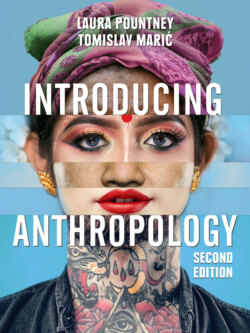Читать книгу Introducing Anthropology - Laura Pountney - Страница 12
Key issues and debates
ОглавлениеHow and when did Homo sapiens evolve?
How similar are humans to other animals and in what ways are they different?
What methods do we use to find out about early humans?
How did different groups of early humans interact and what can this tell us about humans today?
What impact has humanity’s specific biological evolution had in terms of shaping our cultural evolution: what is the relationship between human biology and culture?
To what extent do humans vary?
The question of what makes human beings different from all other species is central to anthropology. This chapter explores the particular characteristics that, over the past 6–7 million years, since they shared a common ancestor with apes, have allowed Homo sapiens to become the most successful of the primates. We now know that there were many types of early human, so this chapter explores how Homo sapiens interacted with other forms of early human, and what this tells us about humans today. It also looks at the behavioural and physical traits that humans continue to share with other primates, such as chimpanzees and bonobos. The study of human origins and of the adaptations that make our species unique defines the field of evolutionary anthropology. This field overlaps with paleontology, which is the study of life on earth, drawing on information provided by fossil remains. This field overlaps with archaeology, which is the study of early human objects, or artefacts, that tell us what early human life was like.
primate A mammal of the order Primates, characterized, for example, by refined development of the hands and feet and a large brain
paleontology The study of life on earth, often drawing on information provided by fossils
One of the first evolutionary anthropologists was Charles Darwin, creator of the theory of evolution. Evolutionary anthropology has since grown into a multifaceted discipline investigating the origins of humanity through fossils and, more recently, ancient DNA, and genetic analyses. This is supported by an ever-clearer picture of what make humans unique. Among the many features that distinguish us from other species – perhaps the fundamental difference – is the fact that humans have a highly developed culture. Simply put, culture is every aspect of life that goes beyond biology.
Although there is evidence of culture in some other species, nowhere is it more complex, rich and evolved than within human societies. So, how did the specific physical evolution of Homo sapiens lead to the development of a complex culture while that of other species did not? What is the relationship between biological evolution and cultural evolution? If all humans share the same biology, to what extent do they share the same culture? Are there such things as cultural universals?
cultural evolution The ways in which humans have evolved beyond their biology
The final section of this chapter explores the extent of biological variations between humans, making a clear distinction between biological differences and socially constructed ideas about race (which are widely criticized).
